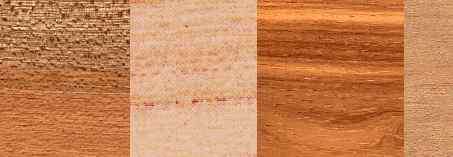
Quaruba (Vochysia lehmanni)
Family: Vochysiaceae
Common names: Barbara chele, Bella maria, Cambara, Canelito, Chimbulla, Corosillo, Dormilon, Goma amarilla, Gomo, Iteballi, Kouali, Kwari, Laguno, Mayo, Palo de chancho, Plumero, Quaruba, Quarubatinga, Quillo, Quillosisa, San Juan de pozo, Sorog
Distributed in: Brazil, Mexico, Peru, Venezuela (Central America, Latin America)
Distribution overview: Several species in the genus Vochysia are distributed throughout tropical America, from southern Mexico to Peru, and are most abundant in the Guianas and Brazil. They are reported to form nearly pure stands on abandoned farmlands, and attain their best development on coastal plains and along waterways.
Common uses: Boat building, Boxes and crates, Canoes, Casks, Chairs, Chests, Concealed parts (Furniture), Decorative plywood, Decorative veneer, Desks, Dining-room furniture, Dowell pins, Dowells, Drawer sides, Figured veneer, Fine furniture, Floor lamps, Furniture , Furniture components, Furniture squares or stock, General carpentry, Hatracks, Interior trim, Kitchen cabinets, Lifeboats, Living-room suites, Moldings, Office furniture, Packing cases, Paneling , Plywood, Radio - stereo - TV cabinets, Rustic furniture, Shipbuilding, Stools, Tables , Utility furniture, Veneer, Wainscotting, Wardrobes
Product sources: The ITTO reports that the species is an important source of timber and rates as a fairly important export.Vochysia timbers are used for the same purposes as those produced by the genus Qualea, and the two genera are often referred to by the same vernacular name in some areas.
Environment profile: Status has not been officially assessed
Tree size: Tree height is 10-20 m
Colors: the heart isPale red to pink, Yellowand the sapwoodColor not distinct from heartwood, White to yellow.The grain isStraight, the textureModerately coarseand the lusterLustrous
Natural durability: Perishable, Susceptible to attack by fungi and termites
Odor: No specific smell or taste
Kiln Schedules: T2 - D4 (4/4); T2 - D3 (8/4) US
Drying Defects: Severe cupping, Severe twisting/warping
Ease of Drying: Reconditioning Treatement
Comments: Easier to work, and can be used for utility plywood, drawer bottoms, and panels
Blunting Effect: Slight effect
Boring: Satisfactory properties
Carving: Good results
Cutting Resistance: Easy to saw
Gluing: Good properties
Mortising: good
Moulding: Good moulding properties
Movement in Service: Good moulding properties
Nailing: Easy to nail, Holds nails well
Planing: Woolly
Resistance to Impregnation:
Preservative absorption and retention is more than adequate in both heartwood and sapwood
Response to hand tools: Works readily with handtools
Routing recessing: Routing is easy
Sanding: Good sanding finish
Turning: Good results
Painting: Responds well to painting
; Polishing: Good; Staining: Stains well
Water-Based stains should be avoided since they tend to raise the grain
;
- Numerical data Metric
- Numerical data English
- Strength properties
- References
 |
 |
 |
 |
| Item |
Green |
Dry |
Metric |
| Specific Gravity |
0,46 |
0,52 |
|
| Density |
|
480 |
kg/m3 |
| Bending Strength |
427 |
760 |
kg/cm2 |
| Crushing Strength |
198 |
411 |
kg/cm2 |
| Hardness |
|
268 |
kg |
| Impact Strength |
|
|
cm |
| Shearing Strength |
|
106 |
kg/cm2 |
| Stiffness |
85 |
100 |
1000 kg/cm2 |
| Tangential Shrinkage |
10 |
|
% |
| Radial Shrinkage |
3 |
|
% |
| Weight |
769 |
480 |
kg/m3 |
| Maximum Load |
0,7 |
0,91 |
cm-kg/cm3 |
| Toughness |
|
109 |
cm-kg |
| Static Bending |
|
|
kg/cm2 |
|
 |  |  |  | | Item | Green | Dry | English | | Bending Strength | 6086 | 10821 | psi | | Density | | 30 | lbs/ft3 | | Hardness | | 593 | lbs | | Maximum Crushing Strength | 2822 | 5846 | psi | | Shearing Strength | | 1509 | psi | | Stiffness | 1210 | 1435 | 1000 psi | | Toughness | | 95 | inch-lbs | | Work to Maximum Load | 10 | 13 | inch-lbs/in3 | | Specific Gravity | 0.46 | 0.52 | | | Weight | 48 | 30 | lbs/ft3 | | Radial Shrinkage | 3 | | % | | Tangential Shrinkage | 10 | | % | | Volumetric Shrinkage | 13 | | % | |
The bending strength of air-dried wood of the species is similar to that of Teak, which is considered to be strong. Compression strength parallel to grain, or maximum crushing strength, is medium. It is lower in this property than Teak. The wood is soft, and surfaces may dent easily. It also does not wear well, and mars easily. The weight is about average. The wood is high in density.
Boone, R.S., C.J. Kozlik, P.J. Bois, E.M. Wengert. 1988. Dry Kiln Schedules for Commercial Woods - Temperate and Tropical. USDA., Forest Service, Preliminary Copy, Forest Products Laboratory, Madison, Wisconsin.Chudnoff, M.,1984,Tropical Timbers of the World,U.S.A. Department of Agriculture, Forest Service, Forest Products,Laboratory, Madison.HMSO.1981.Handbook of Hardwoods, 2nd Edition.Revised by R. H. Farmer.Department of the Environment, Building Research Establishment, Princes Risborough Laboratory, Princes Risborough, Aylesbury, Buckinghamshire.ITTO. 1991. Tropical Timber Atlas of Latin America.Association Internationale Technique des Bois Tropicaux, Centre Technique Forestier Tropical Division of CIRAD, 45 bis, Avenue de la Belle Gabrielle, Nogent-sur-marne, CEDEX, FranceLavers, G.M. 1966. The Strength Properties of Timbers. Forest Products Research Bulletin, No. 50. Ministry of Technology, Her Majesty's Stationery Office, London.Record, S.J. and R.W. Hess. 1943. Timbers of the New World. Published on the Charles Lathrop Pack Foundation, Yale University Press, New Haven CT.
|








